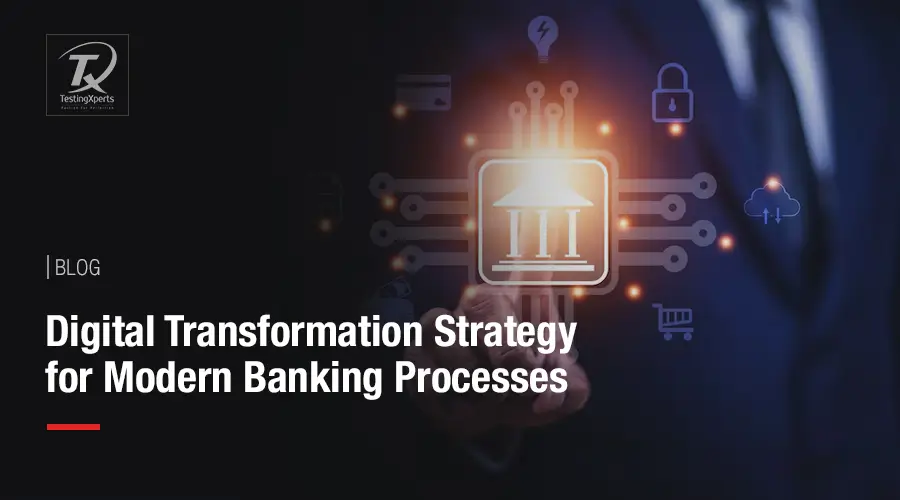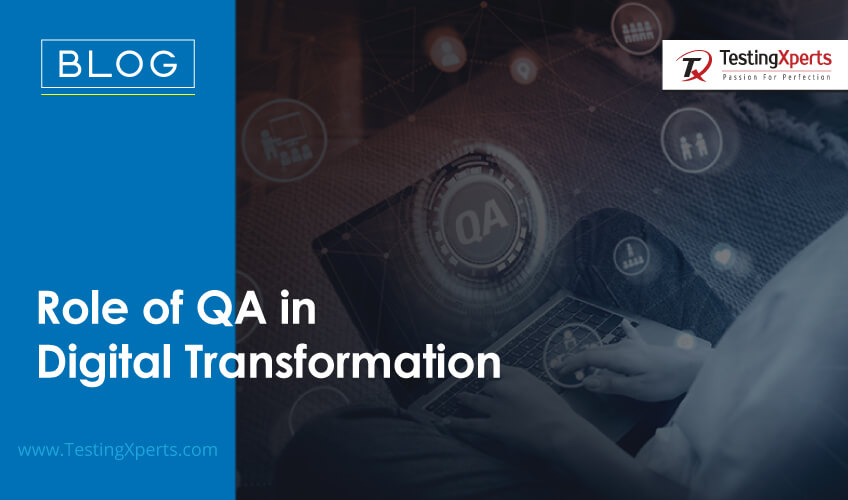
- Digital Transformation in Banking
- Importance of Digital Transformation Strategy in Banking
- 5 Effective Digital Transformation Strategies for Banking Sector
- Technologies Used in Banks & Financial Institutes
- Why Partner with Tx to Support your Digital Transformation Project?
- Summary
The banking sector, known for its traditional brick-and-mortar operations, is now undergoing digital innovations. As the technology landscape and customer demands evolve, the need for seamless and personalized experiences is also growing. This shows that the time for digital transformation in banking is underway. According to statistics, the number of digital banking users in the US will be around 217 million by 2025. Customers nowadays expect excellence in virtual operations, and the wide usage of the Internet and digital technologies have pushed the financial industry to move towards AI and ML solutions.
To remain competitive in the digital market, banks must adopt a digital transformation strategy to unlock new revenue paths, improve risk management, and build robust CX.
Digital Transformation in Banking

Digital transformation in banking involves integrating new technologies and transformation strategies into financial services to optimize processes, enhance CX, and remain competitive in a changing market. Digital technologies like AI/ML, blockchain, cloud, smart contracts, etc., are already shaking up the status quo of financial services. These solutions offer a higher level of security, convenience, and efficiency compared to traditional banking systems.
Traditional banks are adopting digital transformation strategies to fundamentally change how they operate, manage internal processes, and serve customers. The process involves various changes, from integrating digital technologies to upgrading legacy systems and providing better value to customers. In short, digital transformation in banking is about leveraging tech innovations to transform how banks operate, do business, handle their teams, and offer better experiences to their clients/customers. Its key aspects include:
- Offering integrated and seamless experience across channels like mobile apps, net banking, physical branches, and ATMs.
- Leveraging AI, ML, blockchain, and data analytics to provide tailored banking solutions based on customer preferences and needs.
- Implementing RPA and AI to optimize efficiency, streamline operations, and reduce banking costs.
- Leveraging cybersecurity practices to secure critical data, ensure compliance, and prevent theft/fraud.
- Utilizing big data analytics to optimize risk management and facilitate strategic decision-making.
Importance of Digital Transformation Strategy in Banking

Digital transformation is not a new concept in the banking industry. However, it is gaining more popularity now because of the influence of Fintech apps and new operating models on users. One of the primary goals of digital transformation in banking is to optimize overall operational efficiency. The digital transformation strategy will involve manual process automation, implementing digitization to handle paperwork, and leveraging robust platforms for seamless integration across departments.
Another reason digital transformation is vital in banking is to elevate customer experience. In the digital age, customers are tech-enthused and desire easily accessible, highly personalized, and convenient banking services. Digital transformation enables banks to fulfill these requirements with digital channels and self-service options, such as:
- Self-service Kiosks
- Virtual Assistants
- Mobile Banking Applications
- Cardless ATM
Banks can offer a seamless and omnichannel experience, enabling customers to access their accounts, perform transactions, and ask for customer support anywhere and anytime. By integrating artificial intelligence and data analytics, they can further enhance the CX by providing tailored financial services and facilitating 24/7 fraud detection. Also, banks can quickly adapt to changing market structures. This involves partnering with Fintech companies, implementing agile methodologies, and leveraging open banking frameworks. These strategies allow banks to respond swiftly to the latest trends, release new services/products on time, and remain competitive.
5 Effective Digital Transformation Strategies for Banking Sector

The banking sector’s fundamental shift is changing how financial services are formulated, developed, and released. Banks can improve service experience, optimize operational efficiency, and cope with rapidly changing market trends by implementing digital transformation strategies and technologies. But to do so, they require a robust digital transformation strategy. Let’s take a quick look at some of the effective digital transformation strategies for the banking sector:
Customer Experience Optimization:
Implementing omnichannel banking and a personalized and targeted marketing strategy would enable seamless customer experience across multiple channels. The omnichannel banking will help provide a digital banking experience at the physical branches and ensure better interaction between the bank and the customers. Targeted marketing involves leveraging customer data and AI-based analytics to predict customer behavior. This would help send personalized recommendations and offers and improve customer engagement and satisfaction.
Utilize Data and Analytics:
Data-driven decision-making would enable banks to analyze customer behavior, market trends, and transactional data to identify growth areas and trends. Similarly, predictive analytics can analyze historical data to predict customer behavior and future outcomes. It can also help financial institutes assess risks, such as identifying fraudulent activities and checking creditworthiness.
Improve Cybersecurity Practices:
By enabling multi-factor authentication, banks can add an extra security layer to prevent unusual login attempts. Continuous monitoring and advanced threat detection tools would allow them to detect potential threats in the network and initiate the remediation plan swiftly. Also, by encrypting sensitive data, they can ensure it remains unusable and unreadable for unauthorized users. This would help secure customers’ information and other critical data.
Ensuring Regulatory Compliance:
The banks should comply with data protection and privacy regulations (GDPR in the EU, CCPA in the US, etc.) to ensure the legal use of customer data collection and digital channels. With KYC (know your customer) and AML (anti-money laundering), financial institutes can defend against fraud and legal activities. Also, leveraging biometric authentication methods would enable more secure customer identity authentication.
Integrating Emerging Technologies:
What would be a better option to inquire about a transaction? Long queues, complex phone call menus, or a website with a friendly chatbot? Well, we all know the answer. AI-powered chatbots can be virtual assistants offering 24/7 customer service. Also, by deploying RPA (robotic process automation), banks can automate their regular tasks such as data entry, information validation, report generation, etc. This would enable bank employees to focus on value-adding activities.
Technologies Used in Banks & Financial Institutes

Banks need to leverage the latest digital technologies available to facilitate a successful digital transformation. Let’s take a look at the most common digital technologies utilized in banking and financial institutes:
Cloud Computing:
One of the demanding technologies right now is the cloud, which gives on-demand access to computing resources. Banks and financial service providers are now accepting and using this technology to offer seamless services to customers. Cloud computing fosters better operations and flexible, agile, and scalable infrastructure.
Blockchain:
Blockchain’s transparent and data-driven nature makes it a go-to technology for banks and financial institutes. It enables more secure data transactions and an optimized interface to satisfy customer expectations.
AI and ML:
These technologies are utilized in various transformation projects, including process automation, running big data sets analysis, and enhancing UX through personalized services. In banking, AI helps with online assessment, and chatbots can help resolve basic customer queries. Also, ML makes it faster and simpler to track updates and user behavior changes and detect suspicious activities.
APIs:
An application programming interface, or API, is a software interface that allows two or more applications to integrate services instead of individually developing them. This results in better connectivity between businesses and their customers/partners.
Why Partner with Tx to Support your Digital Transformation Project?

The banking industry is shifting from traditional branch-based to digital banking to deliver faster and more seamless services. With the increasing complexities of financial products, tightened regulatory compliances, and the rising demand for digital transactions, the importance of quality control is of the essence. At Tx, we deliver high-quality banking and financial solutions by leveraging our next-gen QA service with AI and RPA-based no-code/low-code automation to support your digital transformation process.
We have established a banking testing CoE (center of excellence) to manage the testing work and deploy ROI-driven test automation for quick quality checks. Our Accelerators, such as Tx-SmarTest, Tx-PEARS, Tx-UiPath, Tx-DevOps, Tx-ReuseKit, and Tx-Automate, seamlessly integrate with your testing cycle, helping reduce testing efforts by 90% and helping you release your services/products faster in the market. Our years of experience in banking LOBs, such as retail banking, investment banking, merchant banking, etc., make us an ideal partner for your digital transformation project.
Summary
The digital transformation process in banking requires a strategic approach to stay ahead in an ever-changing industry like banking. Modern banks are integrating AI, machine learning, blockchain, and cloud computing to optimize processes, enhance customer experience (CX), and improve operational efficiency. Key strategies include leveraging data analytics for decision-making, improving cybersecurity practices, and ensuring regulatory compliance. Technologies like AI-powered chatbots and robotic process automation (RPA) streamline tasks and boost productivity. Partnering with Tx provides AI-driven QA services to accelerate your digital transformation journey. Our in-house tools, such as Tx-SmarTest and Tx-Automate, reduce testing efforts and support faster product releases. To know how Tx can help, contact our experts now.
Discover more
Get in Touch
Stay Updated
Subscribe for more info




